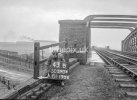I have for a long time now been trying to both confirm some station heights and the heights of two junctions, not easy when both the stations and the line have long since gone.
Normally, I view the 1909 OS map, but yesterday I had a look at some older town map from the 1890's, whilst these only cover towns or part of a town they show much more detail. On them I noticed many BM's (Bench Marks) and decided to have a little read about them. There were half a million of them all around the country at one time.
All of these bench marks state the height above the OD (Ordnance Datum) which is measured at zero feet at Newlyn Harbour in Cornwall. All bench marks have an arrow symbol shown on maps.
Let's take an example: B.M. 277.5
The value 277 from an 1890's map means that location point is 277 feet above Newlyn Harbour.
I decided to check John Marshall's profile gradient for my old branch line and his station heights correspond with the BM heights. He has Padiham station at 272 feet. Looking along the track area through the station, heights vary only slightly from 271.4 to 271.8, so for me 272 is good enough.
Using these bench marks and corresponding spot heights from the older town maps for me is the answer.
I wondered (as Padiham station was above road level) just how high up it was, looking at one photo in particular I guessed about 20 feet above, but was I close? Following the tracks East out of the station they cross over Station Road via two parallel bridges, and between the bridges (at road level) it states a height of 254.0, the track level says 271.something which gives a difference of 17 feet. The bench mark actually on the platform gives 277.50 a difference of 23 feet. Take off the height of the platform and we get to something like 20 feet - so it was a reasonable guess.
Using these older town maps, understanding what bench marks are telling you, you can get to some reasonable height details. I was able to confirm Great Harwood Junction (Blackburn) was 406 feet, something that John didn't make a note of, and Padiham Junction (Rose Grove West) is around 450 feet although there is a lack of bench marks for this one.
You can have a look at this example here:
NLS Padiham 1890
I hope this is a little clearer than mud! and it may help some of you find those heights.
One question though: If a BM has a height of say 271.8 - what is the .8? eight inches? a percentage of a foot?
Normally, I view the 1909 OS map, but yesterday I had a look at some older town map from the 1890's, whilst these only cover towns or part of a town they show much more detail. On them I noticed many BM's (Bench Marks) and decided to have a little read about them. There were half a million of them all around the country at one time.
All of these bench marks state the height above the OD (Ordnance Datum) which is measured at zero feet at Newlyn Harbour in Cornwall. All bench marks have an arrow symbol shown on maps.
Let's take an example: B.M. 277.5
The value 277 from an 1890's map means that location point is 277 feet above Newlyn Harbour.
I decided to check John Marshall's profile gradient for my old branch line and his station heights correspond with the BM heights. He has Padiham station at 272 feet. Looking along the track area through the station, heights vary only slightly from 271.4 to 271.8, so for me 272 is good enough.
Using these bench marks and corresponding spot heights from the older town maps for me is the answer.
I wondered (as Padiham station was above road level) just how high up it was, looking at one photo in particular I guessed about 20 feet above, but was I close? Following the tracks East out of the station they cross over Station Road via two parallel bridges, and between the bridges (at road level) it states a height of 254.0, the track level says 271.something which gives a difference of 17 feet. The bench mark actually on the platform gives 277.50 a difference of 23 feet. Take off the height of the platform and we get to something like 20 feet - so it was a reasonable guess.
Using these older town maps, understanding what bench marks are telling you, you can get to some reasonable height details. I was able to confirm Great Harwood Junction (Blackburn) was 406 feet, something that John didn't make a note of, and Padiham Junction (Rose Grove West) is around 450 feet although there is a lack of bench marks for this one.
You can have a look at this example here:
NLS Padiham 1890
I hope this is a little clearer than mud! and it may help some of you find those heights.
One question though: If a BM has a height of say 271.8 - what is the .8? eight inches? a percentage of a foot?




